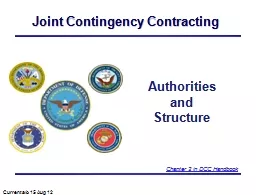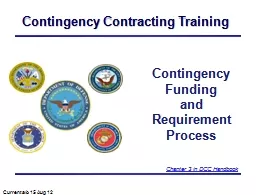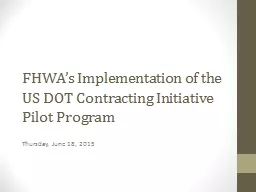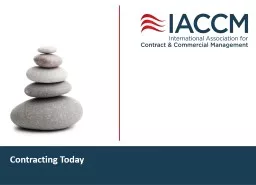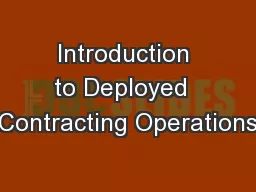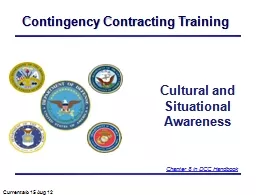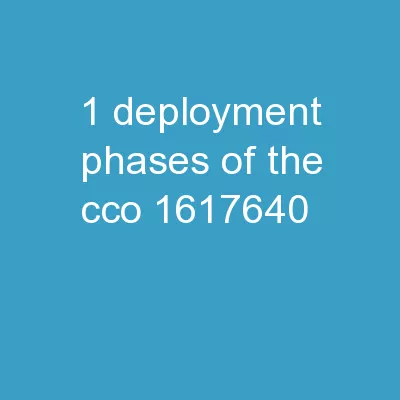PPT-Contingency Contracting Training
Author : lindy-dunigan | Published Date : 2016-03-08
Planning and Guidance Current ao 15 Aug 12 Chapter 4 in DCC Handbook 2 Overview Key Points Introduction Types of Contingencies Predeployment Planning Plugging
Presentation Embed Code
Download Presentation
Download Presentation The PPT/PDF document "Contingency Contracting Training" is the property of its rightful owner. Permission is granted to download and print the materials on this website for personal, non-commercial use only, and to display it on your personal computer provided you do not modify the materials and that you retain all copyright notices contained in the materials. By downloading content from our website, you accept the terms of this agreement.
Contingency Contracting Training: Transcript
Planning and Guidance Current ao 15 Aug 12 Chapter 4 in DCC Handbook 2 Overview Key Points Introduction Types of Contingencies Predeployment Planning Plugging in Downrange NATO Tasking. Cultural and Situational . Awareness. Current a/o 15 Aug 12. Chapter 8 in DCC Handbook. 2. Overview. Key Points. Cultural Awareness. Situational Awareness. Communication with Vendors (Elicitation, Espionage, and Subversion) . Authorities. and. Structure. Current a/o 15 Aug 12. Chapter 2 in DCC Handbook. 2. Overview. Key Points. Contracting and Command Authority. Contingency Contracting Officers (CCOs) Authority. Contracting Structure. Contingency . Funding . and Requirement Process . Current a/o 15 Aug 12. Chapter 3 in DCC Handbook. 2. Overview. Key Points. Fiscal Law Constraints. Purchase Requests. Contracting Related Boards. Types of Funding. Agile Contracting Support…Anytime…Anywhere. Types of Contingencies. 2. Overview. Define and Explain contingency contracting. Identify sources of guidance for performing contingency contracting. Compare the various types of contingencies. Thursday, June 18, 2015. 2015 Contracting Initiative Pilot Program and . Notice of Proposed Rule Making. March 6, 2015 – “Contracting Initiative” Pilot Program Federal Register Notice. Specifically allows labor hiring preferences for:. Naval Acquisition Development Program. 2016 Annual Symposium. March 24, 2016. Tom Frankfurt. Assistant General Counsel. (Research, Development, & Acquisition). 1. Topics. Organizational Conflicts of Interest. Improving Legal Compliance while Increasing . Economic Opportunities . for Low-Income Pennsylvanians. RHLS. related components — . community and economic development, utility matters and preservation of home ownership. RHLS provides innovative project and policy solutions that help create sustainable communities offering decent, safe and affordable housing for lower-income Pennsylvanians. The purpose of contracts. Digital technologies are transforming . markets, . supply . chains and operational interdependencies. Society is demanding increased supplier . responsibility and integrity. Leadership Theories. Chapter 4. Part One: Individuals As Leaders. Learning Outcomes 1 – 5 . State the major difference between behavioral and contingency leadership theories, and explain the behavioral contribution to contingency . March 31, 2017. Agenda. Technical discussion of PTPs in Contingency Analysis. Alternative implementation. Next Steps. 2. Overview. A PTP is modeled as a simultaneous injection and withdrawal – a linked bid and offer. MSgt Mike Ventura. TSgt Marcus Webb. Det 1, 823 RHS / CON. Overview. Operational Chain of Command. Contracting Authority - Functional Chain of Command. CCO Support to Deployed Operations. Funding Considerations. Overview. Contracting / USCENTAF Websites. Silver Flag CCO Disc (Student Booklet and Folder). DAU Virtual Tour. Defense Acquisition Deskbook (CD-Rom). Van Matthews Guide. Additional Sources. References. Cultural and Situational . Awareness. Current a/o 15 Aug 12. Chapter 8 in DCC Handbook. 2. Overview. Key Points. Cultural Awareness. Situational Awareness. Communication with Vendors (Elicitation, Espionage, and Subversion) . MSgt Mike Ventura. TSgt Marcus Webb. Det 1, 823 RHS/CON. Overview . Predeployment …………………………. CC-302. Initial Deployment ……………………… CC-502-1. Build-up …………………………………. CC-502-2 .
Download Document
Here is the link to download the presentation.
"Contingency Contracting Training"The content belongs to its owner. You may download and print it for personal use, without modification, and keep all copyright notices. By downloading, you agree to these terms.
Related Documents


